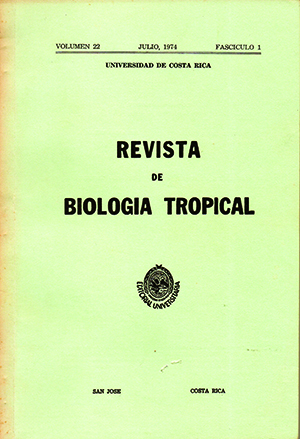Abstract
A new species of characid fish, in which the males have greatly enlarged scales on the middle of the flanks, is described from southern Costa Rica. During courtship the expanded tips of these "paddle sea les" serve as a stimulus to the female which later takes a spermatophore into her mouth. The peculiar sexual dimorphism of P. myrnae is described and coloration of live specimens, courtship behavior and ecology arc discussed.
The genus Pterobrycon is redescribed and the new form is compared to its only congener, P. landoni Eigenmarm of the Río Atrato, Colombia. Microbrycon minutus Eigenmann and Wilson is placed in the synonymy of P. landoni. Each species of Pterobrycon occupies a region of tropical wet lowland forest which is presently isolated from other such areas by a dry forest biotope. During the humid climate of the Pleistocene glacial periods, wet forest broadly connected the Central American and Colombian lowlands. The dry climatic periods of the interglacials and post Pleistocene have isolated Central American from Colombia n humid forest refuges and resulted in the sub-division of Pteroblycon, Rhoadsia, Nannorhamdia, Gymnotus and perhaps other fish genera.
References
AXELROD, D. I. 1952. A theory of angiosperm evolution. Evolution, 6: 29-60.
BOHLKE, J. 1958. Studies on fishes of the family Characidae. No. 14. A. report on several extensive recent collections from Ecuador. Proc. Acad. Nat. Sci. Phila 110: 1-121.
BUSSING, W. A. 1970. Two new species of catfishes of the genera Nannorhamdia and Imparales (Family Pimelodidae) from Central America. Los Angeles Co. Mus., Contrib. Sci., 196: 1-11.
BUSSING, W. A. 1975 . Geographic distribution of the San Juan Ichthyofauna of Central America, with remarks on its origin and ecology. In T. R. Thorson, (ed.), Investigations of tbe ichthyology oi tbe Great Lakes of Nicaragua. Univ. Nebraska Press (in press).
BUSSING, W. A., & T. R. ROBERTS. 1971. Rediscovery of the glandulocalldine fish Pterobrycon and hypothetical significance of its spectacular humeral scales. (Pisces: F. Characidae). Copeia, 1971: 179-181.
CORWiN, 1933. Corynopoma riisei. Fisb Culturist, Phila., 13: 31-33.
DORF, E. 1959. Climatic changes of the past and present. Contrib. Mus. Paleortol. Univ. Mich., 13: 181,210.
EIGENMANN, C. H. 1913. Some results from an ichthyological reconnaissance of Colombia, South America. II. Indiana Unitl. Sludies, 18: 1-30.
EIGENMANN C. H. 1914. New fishes from western Colombia, Ecuador, and Peru. Indiana Unit. Sludies, 19: 1-15.
EIGENMANN, C. H., & G . S , MYERS. 1929. The American Characidae. Mem. Mus. Comp. Zool. Harvard, 43: 429-574.
GREY, M. 1947. Catalogue of type specimens of fishes in Chicago Natural History Museum. Fieldiana: Zool., 32: 109-205.
HAFFER, J. 1967. Speciation in Colombian forest birds west of the Andes. Mus. Novit., 2294: 1-57.
LOFTIN, H. G. 1965. The geographical distribution of freshwater f;shes in Panamá. Ph. D. dissertation, Florida State Univ., Tallahassee, Florida.
SAVAGE, J. M. 1966. The origins and history of the Central American herpetofauna. Copeia, 1966: 719-766.
SIMPSON, G. G 1950. History of the fauna of Latin America. Amer Sd., 38: 361-389.
WHITMORE, F. c., JR., & R. H. STEWART. 1965. Miocene mammals and Central American seaways. Science, 148: 180-185.
##plugins.facebook.comentarios##

This work is licensed under a Creative Commons Attribution 4.0 International License.
Copyright (c) 1974 Revista de Biología Tropical


